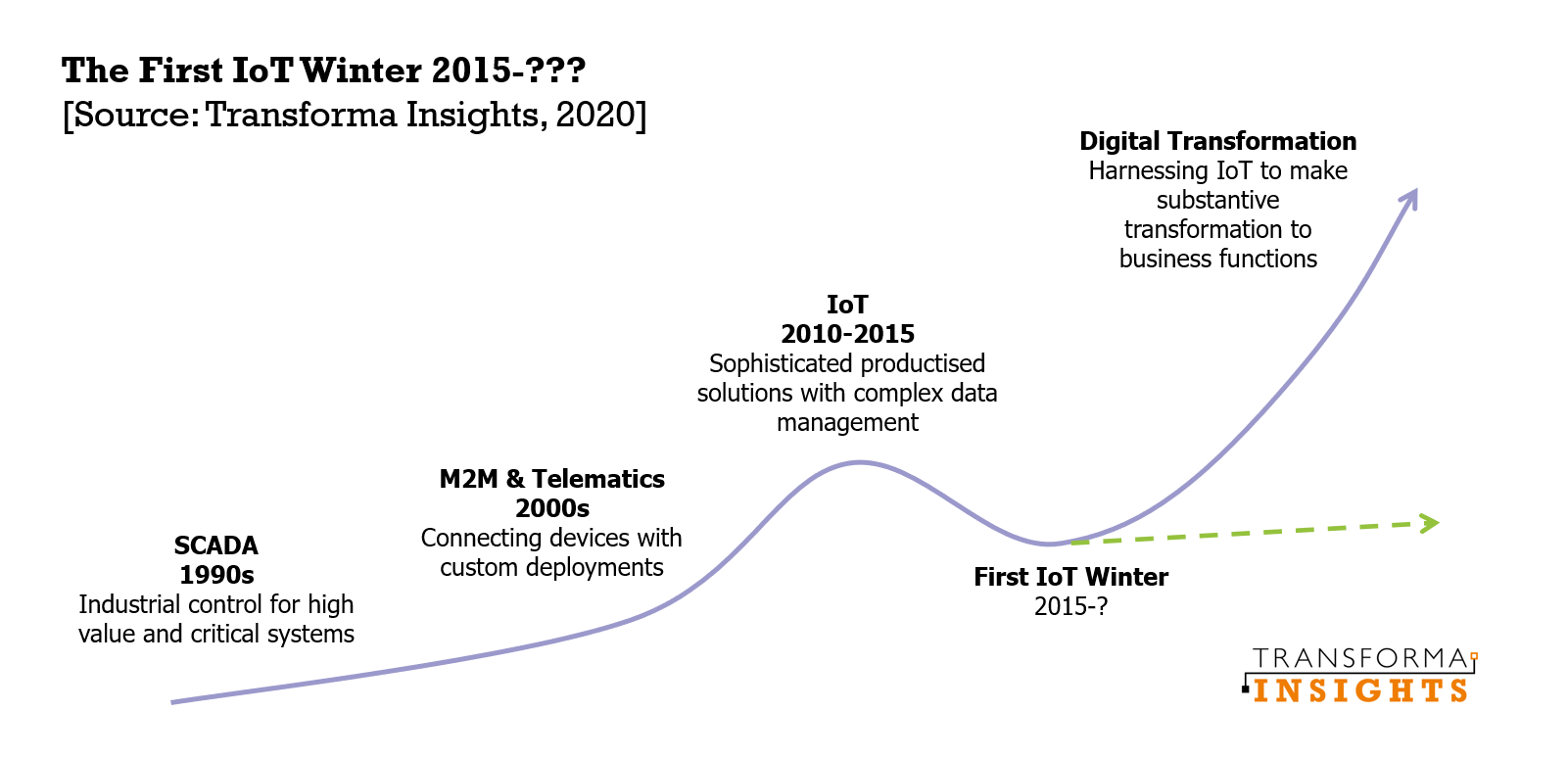Is this the first IoT winter?

Is the Internet of Things (IoT) going through its ‘First IoT Winter’ between 2015 and 2020? Based on his recent book ‘The Internet of Things Myth’ and work by Transforma Insights looking at IoT deployments, says Matt Hatton, founding partner, Transforma Insights.
People involved with Artificial Intelligence talk about ‘AI Winters’, the first in the 1970s, the second mid-’80s to mid-’90s, and we may be on the cusp of a third. These winters are fallow periods following rapid technological development, during which there is a collective realisation that the next step is not a simple linear progression but requires a fundamental change in approach, for instance with Deep Learning. Did IoT just go through its own ‘First IoT Winter’?

The analogy is strong. Between 2010 and 2015 we saw significant erosion in barriers to adopting IoT, allowing it to emerge from the old concepts of machine-to-machine (M2M) and telemetry. IoT platforms arrived, with the likes of Jasper, ThingWorx, Lumada, SAP HANA making the task of developing IoT applications and managing the associated devices substantially easier. New networks arrived in the form of Sigfox, LoRa and Weightless aimed at supporting the use cases that were supposed to trigger billions of connected devices. Network operators threw themselves wholeheartedly at the opportunity, helping dramatically cut the cost of connecting devices. IoT grabbed the imagination and the technologists built some outstanding tools for realising it.
Then it went quiet …
In about 2015 things went quiet. The aim of reaching 50 billion devices by 2020 was jettisoned. A host of collective mistakes effectively created the First IoT Winter. This week, two IoT industry veterans, Matt Hatton and William Webb, published a book entitled ‘The Internet of Things Myth’ which digs into what went wrong between 2010’s sky-high expectations and the reality of 2020. There is not space here to list everything in detail, but we can summarise a few.
Products came to market that were either ill-considered or suffered from a poor user experience. Who wants a connected corkscrew? Will Philips and Sonos customers accept a device lifetime for lighting or music equipment that is more typically associated with smartphones? Will users forget the Jeep hacking or the Ring Santa Claus incident? None of this helps to encourage adoption. Developers got carried away, and there was a failure to realise that applying software development practices to hardware markets was inappropriate.
We saw technology fragmentation. This was inevitable with new arrivals, but during the 2015-20 period there was no consolidation onto a single standard for wide-area connectivity; indeed fragmentation has become worse with the arrival of several new technologies. There were other persisting technology issues such as permanent roaming and 2G/3G switch-off making decisions over technology choices harder for adopters.
Some vendor fails
Vendors did not cover themselves in glory in addressing IoT. The book discusses some lessons in hubris from vendors. In many cases they seemed more interested in extending their position in the value chain and growing their valuation through software acquisitions than in delivering value.

Matt Hatton
There were also problems for adopters: IoT was harder than it looked. IoT was frequently run by IT as a test of technology with no rational plan for how to adapt it within the organisation. Adoption focused on simple incremental enhancements to the organisation’s operations. Few enterprises had navigated the necessary C-level buy-in and organisational and operational change required to take advantage of the transformational capabilities enabled by IoT. This is supported by research from Transforma Insights published last week which showed that fewer than 25% of IoT projects had a significant impact on the enterprise’s external products compared to 70% on internal organisational processes.
Time for real Digital Transformation
This begs the question: what can be done to haul IoT out of IoT Winter? A lot of the problem stems from the need to overcome inertia both for enterprises and consumers. Ultimately, it needs enterprises to recognise IoT as a much-needed competitive differentiator justifying making the painful internal changes necessary to harness the technologies. The phrase ‘Digital Transformation’, which has been floating around for a while, is as good a term as any to use for this change.
Suppliers can do a lot to help. Firstly, they can assist by having the industry catalyse around a single standard for wide area connectivity for IoT, rather than the existing fragmentation. Secondly, by focusing on delivering value in their part of the value chain, rather than worrying about expanding into other already well-served spaces. Finally, by following some simple rules on best practice, for instance around unacceptable user experiences, establishing credibility of being around for the long haul, security practices, and steering clients towards making the necessary internal changes to really embrace IoT.
The Internet of Things Myth is available to buy in Paperback and Kindle formats from Amazon.
The author is Matt Hatton, founding partner, Transforma Insights.
Comment on this article below or via Twitter@IoTGN
